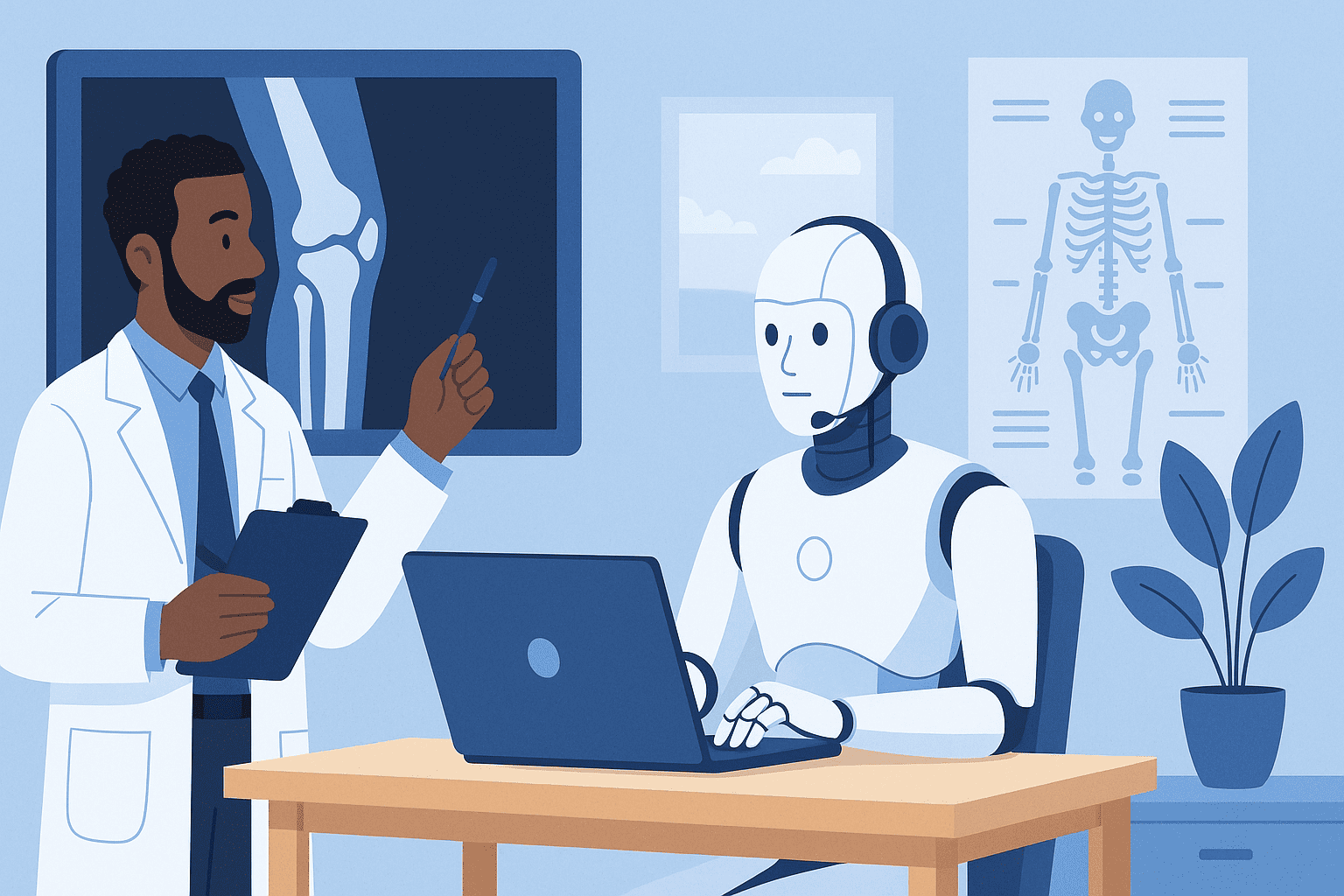Updated on: July 15, 2025
From evaluating fractures and torn ligaments to managing post-op recovery, orthopedic specialists juggle a heavy clinical and procedural load. But documenting each exam, test result, and surgical follow-up shouldn’t take more time than the patient encounter itself.
With DocScrib’s AI medical scribe for orthopedics, your notes are generated automatically—saving hours each week and helping you stay focused on diagnosis, surgery, and rehabilitation, not paperwork.
Why Orthopedic Documentation Is Complex
An orthopedic visit typically involves:
-
Chief complaints: pain, swelling, weakness, instability
-
Detailed musculoskeletal exams (ROM, gait, tenderness, deformity)
-
Imaging (X-ray, MRI, CT, US)
-
Procedures (injections, aspirations, ORIF, arthroscopies)
-
Rehab plans and surgical follow-ups
-
Patient education and return-to-activity counseling
Manual documentation often leads to delays, missed details, and after-hours charting.
What Is an AI Medical Scribe for Orthopedics?
DocScrib for Orthopedics listens to your clinical conversations and converts them into structured EMR-ready notes in real time. It captures:
-
Joint-specific exams
-
Imaging interpretations
-
Procedural steps
-
Post-op assessments
-
Chronic condition tracking (OA, RA, tendonitis, bursitis)
Unlike voice dictation, it understands MSK-specific terminology and context.
How DocScrib Works in Orthopedic Practice
-
Begin the encounter
The AI listens securely in the background (clinic or telehealth). -
Real-time interpretation
It captures orthopedic vocabulary, joint assessments, and surgical planning. -
Note generation
Full SOAP, follow-up, or procedural notes are ready instantly. -
Review & sync
You approve the note and send it directly to the EMR.
Why Orthopedic Surgeons Choose DocScrib
🏃 Captures Musculoskeletal Exams Precisely
Joint ROM, strength, swelling, instability, and special test results (e.g., Lachman, McMurray) are documented accurately.
🦴 Integrates Imaging Summaries
Auto-inserts relevant X-ray, MRI, or ultrasound findings into the encounter.
🛠️ Logs Injections and In-Office Procedures
Corticosteroid injections, aspirations, and cast care documented with standard templates.
🔁 Supports Surgical Planning & Post-Op Follow-Ups
From pre-op education to 6-week post-op recovery—your notes stay consistent and comprehensive.
🧠 Tracks Long-Term Ortho Conditions
OA, spinal stenosis, tendonitis, bursitis, and other chronic MSK issues logged with progress and treatment responses.
DocScrib Features Tailored to Orthopedics
-
Joint-Specific SOAP Templates
Shoulder, knee, hip, spine, hand/wrist, ankle/foot, etc. -
ROM & Strength Documentation
Auto-populates findings from physical exams like degrees of motion and muscle grades. -
Imaging Parser
Summarizes radiographs, MRIs, and CT reports into readable clinical context. -
Procedure Templates
Built-in notes for injections, aspirations, cast removals, and surgical prep. -
Post-Op Recovery Notes
Includes wound checks, mobility updates, pain management, and PT progress.
Top Use Cases for DocScrib in Orthopedic Clinics
-
Joint Pain Consults: HPI, exam, imaging results, injection vs. surgery discussion
-
Sports Injuries: Ligament tests, MRI reviews, return-to-play notes
-
Fracture Follow-Ups: Splint/cast care, radiographic healing, rehab plans
-
Surgical Post-Ops: ROM updates, pain control, incision status
-
Chronic MSK Conditions: Progress tracking for OA, RA, tendonitis
-
Spine Cases: Neuro exam documentation, imaging integration, surgical planning
Real-World Case: Midwest Ortho Practice
📍 3 orthopedic surgeons + 2 PAs
In 30 Days Using DocScrib:
-
Reduced note time per patient from 12 min to under 3
-
Improved post-op documentation compliance
-
Better tracking of ROM over time for total joint patients
-
Allowed 1–2 more patients per day per physician
💬 “I used to chart after dinner every night. Now, my notes are done before the patient leaves the room.”
DocScrib vs. Manual Ortho Note-Taking
| Feature | Manual Notes | DocScrib AI Scribe |
|---|---|---|
| Joint Exams | Manually typed | ✅ Auto-generated |
| Imaging Summaries | Copied into notes | ✅ Parsed & inserted |
| Procedure Documentation | Time-consuming | ✅ Built-in templates |
| ROM & Strength Logs | Often skipped | ✅ Automatically logged |
| Chronic Care Tracking | Inconsistent | ✅ Structured over time |
| Time Per Note | 10–15 min | ✅ Under 2 min |
FAQs: AI Scribes for Orthopedics
Q1. Can DocScrib capture detailed joint exams (e.g., knee or shoulder)?
Yes—it documents range of motion, special test results, tenderness, swelling, and muscle strength.
Q2. How does it handle surgical or injection procedures?
DocScrib includes pre-built templates for injections, cast changes, arthroscopies, ORIF, and post-op visits.
Q3. Will it integrate my imaging notes?
Yes—it can summarize or pull in key findings from radiology reports or spoken interpretation.
Q4. Is it EMR-compatible and HIPAA-compliant?
Absolutely. DocScrib is HIPAA-compliant and integrates with most major EMRs.
Get Started with DocScrib for Orthopedics
-
Book a free demo
-
Select “Orthopedics” as your specialty
-
Customize templates for joints, spine, procedures, and post-op care
-
Start documenting faster—without missing clinical detail
Conclusion: Stronger, Faster Notes for Stronger, Healthier Patients
Orthopedic care moves fast—from injury to diagnosis to rehab. Don’t let documentation slow you down.
With DocScrib’s AI medical scribe for orthopedics, your notes are smarter, faster, and tailored to the MSK conditions you manage every day.
🩺 Get back to motion—not paperwork → Try DocScrib for Orthopedics
